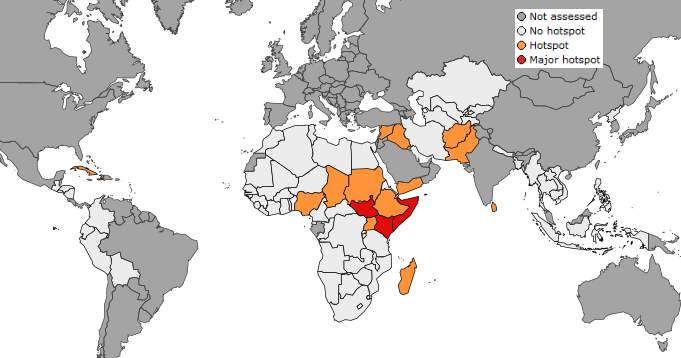
© European Union, 2022
Main findings of the September global overview:
- In Southern Africa, the main season has ended with a cereal output close to the 5-year average, and is approximately 10% lower than last year’s record high (FAO). Towards the end of the winter cropping season, positive production prospects are reported for winter wheat in South Africa and Zimbabwe.
- Although above-average rainfall in August and almost average rainfall in September in the northern part of East Africa benefited crop conditions, the region is still suffering from the impact of exceptional and prolonged drought, which has caused the failure of first season crops and high livestock mortality rates in large parts of Ethiopia, Somalia, Kenya and South Sudan. A risk of famine has been confirmed as conflict, climate extremes, economic shock, rising food and energy prices are pushing millions towards starvation in East Africa. Without urgent assistance, Somalia is projected to face its second famine in just over a decade.
- In the Middle East, the harvest of irrigated summer crops is nearing completion and prospects are below average in Syria and Iraq and almost average in Iran. In Yemen, the harvest of wheat and sorghum started in September with good prospects thanks to above-average rainfall from July to August across the country.
- In West and Central Africa, the preliminary forecast for cereal production is around 74.3 million tons, close to the 5-year average and 3% above the 2021 output (FAO). Localised crop production shortfalls are expected in parts that have been affected by flooding and where conflict continues to disrupt livelihood activities. Thanks to abundant rains in recent months, the pastoral season is progressing under favourable conditions across most parts of the region.
- In Central Asia, maize and spring cereals have been harvested with good prospects. In Kazakhstan and Afghanistan, the harvest of spring wheat was completed in September with mixed prospects. In Afghanistan, 50% of the population (20 million people) is still in need of food assistance due to a strong socio-economic crisis. In South Asia, in Pakistan, heavy rainfall caused flooding across 800 000 ha of cropland and orchards. In Bangladesh, conditions remain favourable for the growth of Aman rice. In Sri Lanka, the harvest of second (Yala) rice and maize crops was completed with 40% less production than in 2021 (a very good year) due to lack of fertiliser and fuel (FAO), despite above-average crop biomass.
- In continental South-East Asia and the Philippines, prospects for wet season rice and prospects for dry season rice in Indonesia are favourable thanks to good rainfall conditions. Similarly, in North Korea, prospects for rice and maize are favourable thanks to good rainfall in the last 3 months.
- In Central America, countries finished sowing Postrera crops (beans, maize, rice, sorghum) under mixed rainfall conditions. Monthly rainfall was below average in parts of southern Guatemala, El Salvador, parts of eastern Nicaragua and most of Haiti, whereas above-average accumulation was registered in most of Honduras and parts of central Cuba. At the end of the month, hurricane Ian brought excess rainfall to Central America and resulted in severe and widespread damage in the province of Pinar del Rio, Cuba. Additionally, rice production in western Cuba might be further reduced due to the excess rain and strong winds.
The next assessment is scheduled for the end of October 2022.
Details
- Publication date
- 6 October 2022
- Author
- Joint Research Centre
